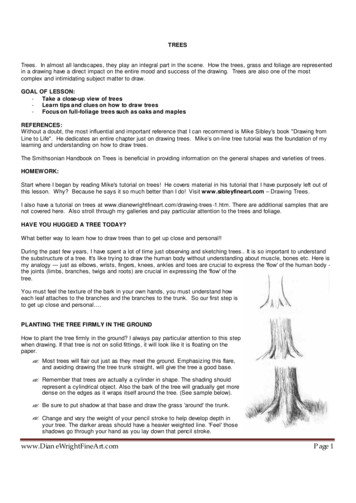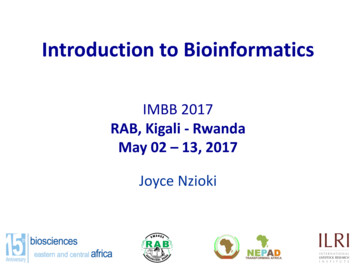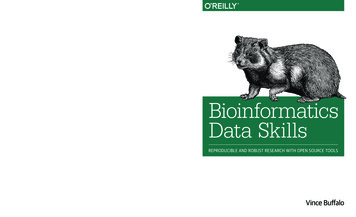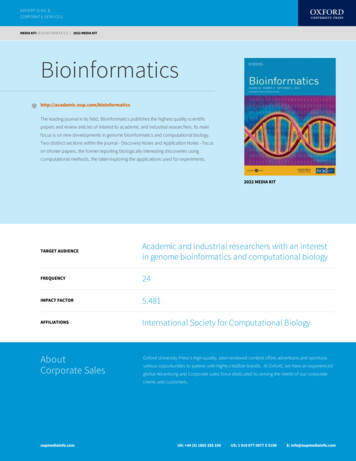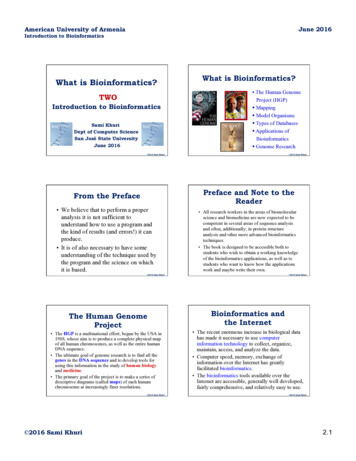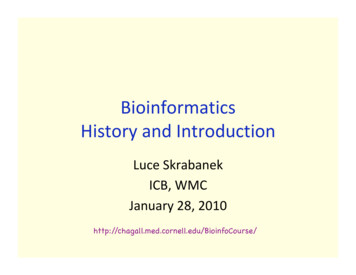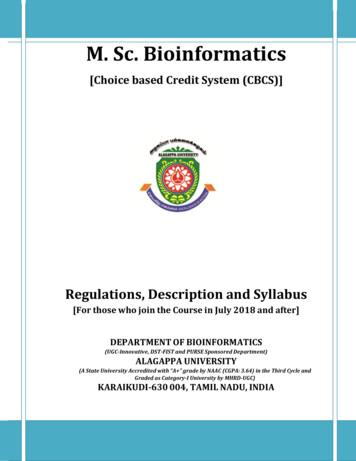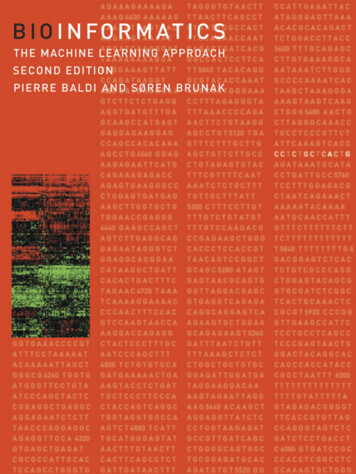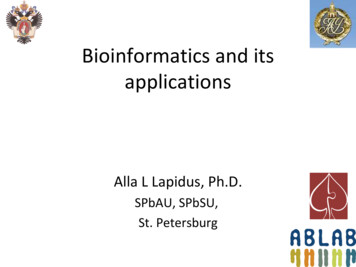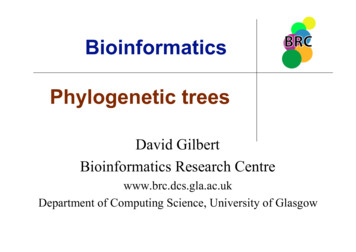
Transcription
BioinformaticsPhylogenetic treesDavid GilbertBioinformatics Research Centrewww.brc.dcs.gla.ac.ukDepartment of Computing Science, University of Glasgow
Overview PhylogenticsTrees– Definitions– Properties Molecular clock[s]Tree [re]constructionDistance methods– UPGMA– Neighbour-joining Mostly based on Chapter 7‘Building PhylogeneticTrees’ from R. Durbin et al‘Biological SequenceAnalysis’ CUP 1988Character methods– Maximum parsimony– Maximum likelihood Assessing trees– Bootstrapping trees(c) David Gilbert 2008Phylogenetic Trees2
Phylogenetic Trees Phylogeny : The evolutionary history and line of descent of aspecies Phylogenetic Tree : A diagram setting out the genealogy of aspecies Purpose– to reconstruct the correct genealogical ties between related objects– To estimate the time of divergence between them since they lastshared a common ancestor Objects typically are protein or nucleic acid sequences(c) David Gilbert 2008Phylogenetic Trees3
What is phylogeny good for? Evolutionary history (“tree of life”)Population historyRates of evolutionary changeOrigins of diseasesPrediction of sequence functionCan be applied to organisms,sequences, viruses, languages,etc. Rod Page(c) David Gilbert 2008Phylogenetic Trees4
Rod Page(c) David Gilbert 2008Phylogenetic Trees5
Our place in Nature Rod Page(c) David Gilbert 2008Phylogenetic Trees6
HIV: where did it come from andhow is it transmitted?(c) David Gilbert 2008Phylogenetic Trees7
More genomes riumlepraeRickettsiarat(c) David niaemouseAquifexaeolicusArchaeoglobus amaritimaXylellafastidiosaSaccharomyces Salmonellacerevisiae PhylogeneticentericaTreesEscherichia Thermoplasmaacidophilumcoli8
Tree terminologyrootInternal nodeleaf(c) David Gilbert 2008Phylogenetic Trees9
Tree as text( ( A , ( B , C ) ) , D)subtree(A,(B,C))ABCDLeaf label(c) David Gilbert 2008Phylogenetic Trees10
Definition of a tree A tree is eitherA leafor( LeftTree , RightTree)where both LeftTree and RightTree are trees(c) David Gilbert 2008Phylogenetic Trees11
Trees with labels462 We can add data toA– Leaves– Branches– NodesB2C( A:6 , ( B:2 , C:2 ):4 )64AaccgBacggCagcgA( A[accg] , ( B[acgg] , C[agcg] ) )(c) David Gilbert 2008Phylogenetic TreesBC6:( A , 4:( B, C ) )12
Isomorphic trees( ( A , ( B , C ) ) , D)( ( A , ( C , B ) ) , D)Etc Derive [all] the isomorphic trees and draw them!(c) David Gilbert 2008Phylogenetic Trees13
Isomorphic trees Isotrees(T1,T2) /Two trees T1 and T2 are isomorphic/ifT1 is a leaf and T2 is a leaf and T1 T2ORT1 (L1,R1) , T2 (L2,R2) ANDIsotrees(L1, L2) AND Isotrees(R1, R2)ORIsotrees(L1, R2) AND Isotrees(R1, L2)(c) David Gilbert 2008Phylogenetic Trees14
Trees can be unrootedACefDBAre there alternative rootings?Draw them ABC(c) David Gilbert 2008DPhylogenetic Trees15
Evolution - basic concepts Mutation in DNA a natural evolutionary process DNA replication errors: (nucleotide)– substitutions– insertions– deletions}indels Similarity between sequences– clue to common evolutionary origin, or– clue to common function This is a simplistic story: in fact the altered function of the expressed protein will determineif the organism will survive to reproduce, and hence pass on [transmit] the altered gene(c) David Gilbert 2008Phylogenetic Trees16
“ancestral sequences”Evolution - related sequences{ggcattg aagcattc gaggattagcataagcctaagcatgConvergent evolution: same sequence evolved from different ancestorsBack mutations - mutate to a previous sequence(c) David Gilbert 2008Phylogenetic Treesgacatt“living examples”17
DefinitionsPhylum (phyla pl): A primary division of a kingdom, as of the animal kingdom,ranking next above a class in size.Phylogeny:– the sequence of events involved in the evolutionary development of a species ortaxonomic group of organisms– Evolutionary relationships within and between taxonomic levels, particularly thepatterns of lines of descent. Phylogenetics -The taxonomical classification oforganisms based on their degree of evolutionary relatedness. Phylogenetic tree - Avariety of dendrogram (diagram) in which organisms are shown arranged onbranches that link them according to their relatedness and evolutionary descent.Phylogentics: study of evolutionary relationshipsPhylogenetic analysis: the means of inferring or estimating these relationshipsTaxonomy: The science of naming and classifying organisms 1. [n] practice ofclassifying plants and animals according to their presumed natural relationships2. [n] (biology) study of the general principles of scientific classification3. [n] a classification of organisms into groups based on similarities of structure ororigin etcTaxon: any named group of organismsSpecies: taxonomic group whose members can interbreed (but more or less able to )(c) David Gilbert 2008Phylogenetic Trees18
Definitions (cont) Clade: a group of biological taxa or species that share features inherited from acommon ancestor; A monophyletic taxon; a group of organisms which includesthe most recent common ancestor of all of its members and all of thedescendants of that most recent common ancestor. From the Greek word"klados", meaning branch or twig. Tree : A data structure consisting of nodes which may contain other nodes viaits branches. Unlike a tree in nature, the root node is usually represented at thetop of the structure and does not have a parent node. All other nodes have asingle parent. Nodes having no child nodes are called leaf nodes Dendrogram: Any branching diagram (or tree) (cf. cladogram, phylogram,phenogram); A dendrogram is a 'tree-like' diagram that summaries the process ofclustering. Similar cases are joined by links whose position in the diagram isdetermined by the level of similarity between the cases. A treelike figure used torepresent graphically a hierarchy. (dendron - greek ‘tree’)(c) David Gilbert 2008Phylogenetic Trees19
Homologues Homologues: sequences that have common originsbut may or may not share common activity Orthologues: homologues produced by speciation.Tend to have similar function Paralogues: homologues produced by geneduplication. Tend to have different functions Xenologues: homologues resulting from horizontalgene transfer between 2 organisms.(c) David Gilbert 2008Phylogenetic Trees20
Tree of orthologues based on a set of ckgoshawkvulture(c) David Gilbert 2008Phylogenetic Treesalligator21
Tree of paralogues:human haemoglobins and n muscles)(c) David Gilbert 2008deltaPhylogenetic Trees22
Orthologues & paraloguesG1:F1AncestralorganismOrthologuesG1A:F1 & G1B:F1G1A:F1Organism A(c) David Gilbert 2008G1B:F1G2B:F2ParaloguesG1B:F1 & G2B:F2Organism BPhylogenetic Trees23
Horizontal (lateral) gene transfer!Bacteria can take up and spread genes in different ways Uptake of naked DNA directly from surroundings Obtain genes from infecting viruses Take up genes through cross-species mating(c) David Gilbert 2008Phylogenetic Trees24
Horizontal gene transfer(c) David Gilbert 2008Phylogenetic Trees25
Phylogenetic TreesApproaches to reconstructing phylogenetic trees Distance based methods Maximum parsimony methods Maximum likelihood methods(c) David Gilbert 2008Phylogenetic Trees26
Phylogenetic analysis - 4 steps1. Alignment / distance computation2. Determine the data model3. Tree building4. Tree evaluation(c) David Gilbert 2008Phylogenetic Trees27
Tree building methods1. Distance-based: Transform the data into pairwisedistances (dissimilarities), and then use a matrixduring tree building. E.g. data from fromimmunology, nucleic acid hybridization, andbreeding experiments, are automatically expressed aspair-wise distances but most character data need tobe mathematically transformed into distances.2. Character-based: Use the aligned characters, suchas DNA or protein sequences, directly during treeinference – based on substitutions.(c) David Gilbert 2008Phylogenetic Trees28
Tree building algorithms Distance-based:– input evolutionary distance data (sequence edit dist; meltingtemp DNA hybridisations, strength of antibody cross reactions.)– Goal: construct weighted tree whose pairwise distances agreewith evolutionary distances– Ultrametric distance data - elegant solution: UPGMA– Additive data - efficient solution: NJ– FM - Fitch-Margoliash– ME - minimum evolution– Not additive - reconstruction not guaranteed; find trees whosedistances “best approximate” given data Rooting trees(c) David Gilbert 2008Phylogenetic Trees29
Metric, ultrametric A metric on a set of objects O is given by the assignment of a realnumber d(x,y) for every pair of objects x,y in O such thatd(x,y) 0 for x yd(x,y) 0 for x yd(x,y) d(y,x) for all x,yd(x,y) d(x,z) d(y,z) for all x,y,z (triangle inequality) In addition, for an ultrametricd(x,y) max(d(x,z) , d(y,z)) An ultrametric tree is characterised by the conditiond(x,y) d(x,z) d(y,z) (for any 3 points their pairwise distances are all equal, or 2 areequal and 1 is smaller)Ages {Fred:20, Mary:22, Jane:24} e.g. add, subtract – are these metric / ultrametric / ?(c) David Gilbert 2008Phylogenetic Trees30
How many pairwise comparisons?ABCDEABCDE How many for whole table? Identity: (x,y) 0for x y Symmetry: d(x,y) d(y,x) for all x,y(c) David Gilbert 2008Phylogenetic Trees31
Metric, Ultrametric trees?metric DistancesultrametricDistance 4(c) David Gilbert 2008EPhylogenetic Trees32
Ultrametric treesDef: Given D a symmetric matrix n by n of real numbers; anultrametric tree for D is a rooted tree T with the followingproperties:1.2.T contains n leaves, each labelled by a unique row DEach internal node of T is labelled by one entry from D and has atleast 2 children3. Along any path from the root to the leaf, the numbers labelling theinternal nodes strictly decrease4. For any two leaves i,j of T, D(i,j) is the label of the least commonancestor of i and j in TDef: A min-ultrametric tree for D is a rooted tree T with all the properties ofan ultrametric tree except that (3) is changed to:3. Along any path from the root to the leaf, the numberslabelling the internal nodes strictly increase(c) David Gilbert 2008Phylogenetic Trees33
Symmetric matrix & Ultrametric tree10ABABCDE01010640410100101006CDE6440DA(c) David Gilbert 2008Phylogenetic TreesBCE34
Obtaining pairwise distances Melting temp DNA hybridisations,Strength of antibody cross reactionsProtein structure comparisonSequences: edit distance and variations– d(i,j) : fraction f of sites u where residues xiu xju differ (assume an alignment)– For 2 unrelated sequences : random substitutions cause f to approach fractionof differences expected by chance, hence:– Jukes-Cantor distance d(i,j) -3/4 * log(1-4f/3) Tends to as equilibrium value of f (75% residues differ) reached(c) David Gilbert 2008Phylogenetic Trees35
Gene sequence distance programs Blast (!) [but ‘score’ increases with similarity ] Clustal[w] – fasta format, but outputs a tree Phylip – its own format – sequences must be ofthe same length hence use clustalw to align thesequences first [output in Phylip format, no tree](c) David Gilbert 2008Phylogenetic Trees36
Clustering methods: UPGMAUnweighted Pair Group Method using Arithmetic AveragesDefine the distance d(i,j) between two clusters Ci and Cj to be the average distance betweenpairs of sequences from each cluster:1d(i, j) Ci " C j d( p,q)p #C i ,q #C jwhere Ci and Cj denote the number of sequences in clusters i and j respectivelyNote that if Ck Ci Cj and Cl is any other cluster then!d(k,l) (c) David Gilbert 2008d(i,l) " Ci d( j,l) " C jCi C jPhylogenetic Trees37
UPGMA algorithmInitialisation: Assign each sequence i to its own cluster Ci Define one leaf T for each sequence, and place it height zeroIterate Determine the two clusters i,j for which d(i,j) [distance i-j] is minimal.(If there are more than two such pairs, pick one at random) Define a new cluster k by Ck Ci Cj, and define d(k,l) for all l byd(k,l) d(i,l) " Ci d( j,l) " C jCi C j Define a node k with daughter nodes i and j, and place it at height d(i,j)/2 Add k to the current clusters and remove i and jTermination! When only two clusters i,j remain, place the root at height d(i,j)/2(c) David Gilbert 2008Phylogenetic Trees38
UPGMA example12345(c) David Gilbert 2008Phylogenetic Trees39
UPGMA example12345(c) David Gilbert 2008t1 t2 d(1,2)/261Phylogenetic Trees240
UPGMA example12345761245t4 t5 d(4,5)/2(c) David Gilbert 2008Phylogenetic Trees41
UPGMA example1283457612453t3 d(3,7)/2(c) David Gilbert 2008Phylogenetic Trees42
UPGMA example12983457612453d(6,8)/2(c) David Gilbert 2008Phylogenetic Trees43
UPGMA tree construction exampleABCABCDE08468088406808DE(c) David Gilbert 20080Phylogenetic Trees44
Like this?(c) David Gilbert 2008Phylogenetic Trees45
Tree(re)constructionGiven: set of sequencesAssume that1 the pairwise sequence alignments provide a measure for the evolutionary distancebetween the sequences2. the the resulting distance matrix constitutes an ultrameric (the ideal case),Reconstruct the phylogenetic, ultrametric tree by the general clustering procedure:Always pick the closest pair from the distance matrix and merge these two objectsinto one.Schemes differ in how the distance between a newly formed object and the other objects isdefined.If object x has been formed by merging y and z, and u is another object:– Single linkage clustering:d(x,u) min(d(y,u) , d(z,u))– maximal linkage clustering: d(x,u) max(d(y,u) , d(z,u))– average linkage clustering: d(x,u) (d(y,u) d(z,u)) / 2(c) David Gilbert 2008Phylogenetic Trees46
Assumptions underlying UPGMA Molecular clock with constant rate– Edge lengths correspond to times measured by clock– Divergences of (sequences) assumed to occur atconstant rate at all points in the tree, I.e.– Sum of times down a path to the leaves from any nodeis the same, whatever choice of path Additivity of edge lengths– Distance between any pair of leaves sum of thelengths of the edges on the paths connecting them– (automatic when UPGMA tree constructed)(c) David Gilbert 2008Phylogenetic Trees47
Incorrect tree construction byUPGMA?ABCABC036050ABC(c) David Gilbert 2008Phylogenetic Trees48
Incorrect tree construction by UPGMA2341What will UPGMA give?(c) David Gilbert 2008Phylogenetic Trees49
Incorrect tree reconstruction by UPGMAABCABCDE0161610606161601616010DE0Construct the tree by UPGMA(c) David Gilbert 2008Phylogenetic Trees50
Addivity & neighbour-joining Possible to have molecular clock property fail but addivityhold Use e.g. neighbour-joining algorithm Does not produce rooted trees (c) David Gilbert 2008Phylogenetic Trees51
Tree whose closest leaves are not neighbours.10.10.4d(1,2) ?, d(1,3) ?20.1Which areneighbouringand which areclosest?0.10.434(c) David Gilbert 2008Phylogenetic Trees52
DistancesHence do not pick closest leaves, but subtract the averageddistances to all other leaves to compensate for long edgesD(i, j) d(i, j) " ( ri rj )where1ri d(i,k) L " 2 k #L(c) David Gilbert 2008Phylogenetic Trees53
Test for additivityFour point condition:For every set of 4 leaves i,j,k,ltwo of the distancesd(I,j) d(k,l) d(I,k) d(j,l), d(I,l) d(j,k)must be equal, and also larger to the thirdCan use NJ even if lengths are not additive, butcorrect reconstruction not guaranteed.(c) David Gilbert 2008Phylogenetic Trees54
Rooting trees Add an outgroup E.g. add axolotl If no outgroup, thenad-hoc strategies See also TreeView byRod Page (Glasgow)(c) David Gilbert 2008moosegiantlesseraxolotl pandapandaPhylogenetic Treesduckgoshawkvulturealligator55
Quick demohttp://www.dina.dk/ sestoft/bsa/Match7Applet.html(c) David Gilbert 2008Phylogenetic Trees56
Parsimony Character-based methodFinds the tree which can explain the observedsequences with a minimal number ofsubstitutions1. Assigns a cost to a given tree2. Searches through all trees to find overallminimum of this cost(c) David Gilbert 2008Phylogenetic Trees57
Parsimony exampleAAGAAAGGAAGAAAAAAA111AGAAAAAAGTotal numberof changes?AGAGGAAAAAAA1AAA1AGAAAG(c) David Gilbert 2008AAAAAA21GGAAAAAAGPhylogenetic TreesAAA2GGA1AGAAAA58
Parsimony method Treats each site independently Given a topology & assignment of residues leaves: Basic step count minimal number of changesneeded at 1 site(c) David Gilbert 2008Phylogenetic Trees59
Weighted parsimony Count number of subsitutions andAdd costs S(a,b) for each substitution of a by bAim : minimise this costWeighted parsimony traditional parsimonywhen S(a,b) 1 for all a b Algorithm starts at the leaves and works up tothe root : post-order traversal(c) David Gilbert 2008Phylogenetic Trees60
Traditional parsimony Just count the number of substitutions : Keep a list of minimal cost residues at eachnode, plus current cost(c) David Gilbert 2008Phylogenetic Trees61
Parsimony : rooted / unrooted Parsimony forumlated for rooted trees Minimal cost in trad.parsimony independent oflocation of root Root can be removed - number of trees to besearched over is reduced But easier to count costs in rooted tree(c) David Gilbert 2008Phylogenetic Trees62
Search stratgeies Improve over simple enumeration Stochastic methods: randomly swap branches on tree and chosealtered tree if better than current– Not guaranteed to find overall best tree; adding sequences in differentorders can give different trees Build tree by adding edges 1 at time [ditto] Branch and bound:– begin systematicall building trees with increasing number of leaves– Abandon avenue whenever current incomplete tree has cost smallestcost obtained so far for complete tree(c) David Gilbert 2008Phylogenetic Trees63
Assessing trees - bootstrap How much trees should be trusted Given dataset of alignment of sequences– Generate artificial dataset (same size) by picking columnsfrom alignment at random with replacement(given column in original can appear several times)– Apply treebuilding to new dataset Repeat many (1000) times Frequency with which phylogenetic feature appears measure of confidence in feature(c) David Gilbert 2008Phylogenetic Trees64
Maximum likelihood Rank trees according to their– likelihood P(data tree)– Posterior probability (Bayesian view) P(tree data) Define & compute the probability of a set ofdata given a tree Need a model of evolution - mutation andselection events that change sequences alongthe edges of a tree(c) David Gilbert 2008Phylogenetic Trees65
Maximum likelihood Maximum Likelihood Given a probabilistic model for nucleotide or aminoacid substitution, select the tree that has the highestprobability of generating the observed data – sequences– Give data D and model M, find tree T such that P(D T, M)maximised Actually what we really want is P(T D, M)– Not so easy to obtain as summation over all possible treetopologies required to obtain posteriorP ( D T , M ) P (T , M )P (T D, M ) ! P( D T , M ) P(T , M )T(c) David Gilbert 2008Phylogenetic Trees66
Phylogenetic Trees Assumptions– Different sites evolve independently– Diverged sequences evolve independently after diverging Consider following tree– Likelihood corresponds to P(D T, M) P(X1,X2,X3 T,M)x5x4x2x3x1(c) David Gilbert 2008Phylogenetic Trees67
Phylogenetic Trees Note that– P(D T, M) P(X1,X2,X3 T,M) X4, X5 P(X1,X2,X3,X4,X5 T,M) X4, X5 P(X1 X4)P(X2 X4)P(X3 X5)P(X4 X5)P(X5) T,M Efficient methods to obtain required summation for likelihood(Felsenstein Algorithm) Have now only obtained likelihood we require maximum of likelihoodover all possible topologies and models (branch lengths) Approximate (stochastic )search methods required(c) David Gilbert 2008Phylogenetic Trees68
Maximum likelihood tree Search over tree topolgies For each topology: search over all possiblelengths of edges (2n-3)!! rooted binary trees with n leaves N 10 :: 2 million, N 20 :: 2.2x1020 Thus need optimisation techniques(c) David Gilbert 2008Phylogenetic Trees69
Probabilistic models of evolution Residue subsitution Deletion & insertion of groups of residues Simple model:– every site independent– only substitutions(c) David Gilbert 2008Phylogenetic Trees70
Maximising likelihood Small number of sequences (2.5) : can enumerate all trees– Write down likelihood as function of edge lengths– Maximise likelihood by numerical technique (Kishano et al 1990, proteinsequences - use PAM matrices) Larger number of sequences: Felsenstein’s algorithm For protein sequences computationally demanding 20x20substitution matrix Can use sampling methods(c) David Gilbert 2008Phylogenetic Trees71
More realistic evolutionary models Different rates at different sites Models with gaps(c) David Gilbert 2008Phylogenetic Trees72
Internet resources and programs Compilation of available phylip/software.html uk.html -- phylip , e.g. for nj ml Phyliphome page [widely used, poor interface ] http://www.hiv.lanl.gov/content/hiv-db/TREE TUTORIAL/Tree-tutorial.html(c) David Gilbert 2008Phylogenetic Trees73
Phylogenetic TreesDifferences between methods UPGMA does not employ models of evolution Maximum Likelihood & Maximum Parsimony employmodels of evolution Maximum Likelihood claimed to be best for largeevolutionary distances– Very time consuming to build trees(c) David Gilbert 2008Phylogenetic Trees74
Summary PhylogeniesTrees, representations, rooted, unrootedMetrics, ultrametrics, additivity, molecular clockDistance methods: UPGMA (ultrametric), NJ(additive; no root) Tree rooting Some Programs(c) David Gilbert 2008Phylogenetic Trees75
Bioinformatics David Gilbert Bioinformatics Research Centre www.brc.dcs.gla.ac.uk Department of Computing Science, University of Glasgow Phylogenetic trees (c) David Gilbert 2008 Phylogenetic Trees 2 Ove

